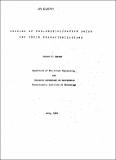| dc.contributor.author | Rafuse, Robert P. | |
| dc.date.accessioned | 2004-09-27T20:15:00Z | |
| dc.date.available | 2004-09-27T20:15:00Z | |
| dc.date.issued | 2004-09-27T20:15:00Z | |
| dc.identifier.uri | http://hdl.handle.net/1721.1/5546 | |
| dc.description.abstract | One of the primary contributors to the system sensitivity threshold in radio telescopes is system-generated, additive Gaussian noise. Thermal and shot noise in active devices used as amplifiers and frequency changers, and background noise introduced from spurious sources into the antenna itself all contribute to a basic limitaion on system sensitivity.
The problem of measurement is intimately connected with that of characterization. Theory and practice only agree when the model used for the theoretical examination is representative of the physical situation and is properly manipulated under a set of "rules for the game" that should be scrupulously adhered to and not bent and deformed, however slightly, to conform to someone's "physical intuition." If the definitive structure set up in Section 2 is properly utilized, the characterization of system noise performance can be reduced to merely rote manipulation of algebraic expressio | en |
| dc.format.extent | 1410388 bytes | |
| dc.format.mimetype | application/pdf | |
| dc.language.iso | en | |
| dc.relation.ispartofseries | Technical Report (Massachusetts Institute of Technology, Research Laboratory of Electronics);705 | |
| dc.subject | amplifiers, frequency changes, physical intuition, rules for the game | en |
| dc.title | Sources of Non-Multiplicative Noise and Their Characterizations | en |
| dc.type | Technical Report | en |
